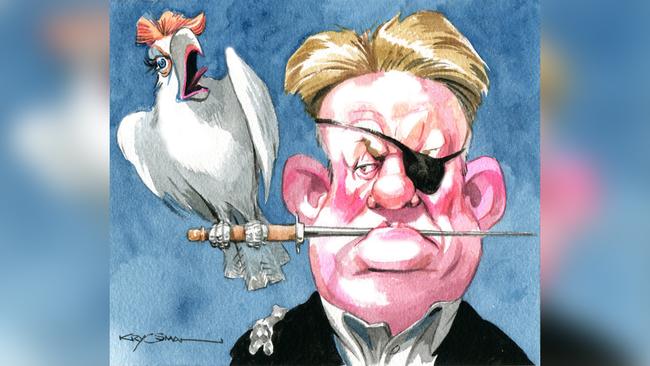
Gough Whitlam was appalled by what Mark Latham had become. Nobody did more to support Latham in his political career. Whitlam employed Latham on his post-prime ministerial staff, mentored him and encouraged his entry into local and federal politics. In the final decades of his life, when I spoke to Whitlam regularly, this was one of his lingering regrets.
What Whitlam would make of Latham’s decision to join the far-right One Nation party led by Pauline Hanson is not difficult to discern. The former prime minister found its populist mix of xenophobia, protectionism and nativism utterly repugnant. Whitlam was an unabashed supporter of immigration and multiculturalism, which has enriched our economic and social life.
Latham always has been a loose cannon. He cannot sustain allegiances, let alone personal or professional relationships. One Nation is his third political party in three years, after the Liberal Democrats and Labor. He was sacked by Sky News and has cycled through periods of writing with The Daily Telegraph and The Australian Financial Review.
In recent years Latham returned to the Labor fold. Just two years ago he offered himself for Labor preselection in the federal seat of Hume in southwest Sydney ahead of the 2016 election. He raised it with local party members. The party’s head office made it clear this was not an option. Latham has been, Labor insiders say, “seat shopping” ever since.
A strong-headed politician such as Latham will not be able to get along with Hanson and won’t last as a member of One Nation. Anybody can see that. Latham can’t last in any political party and can’t get along with anyone professionally. His dalliance with One Nation will end, like everything else, in spectacular style and leave wreckage in his wake. That is the Latham way.
The surprising thing is that Hanson has allowed herself to be duped by yet another man eager to ride on her coat-tails into parliament. Hasn’t she learned the lesson yet? Just ask David Oldfield, her one-time Svengali-like adviser, who also used her star power to catapult himself into the NSW upper house in 1999. That relationship didn’t last either. Hanson burst on to the political scene in 1996, having lost her endorsement as a Liberal candidate for the federal seat of Oxley but winning anyway, and her popularity grew. Then came the wave of MPs elected to the Queensland parliament who almost all eventually split with the party. One Nation has been through various iterations since.
The second coming of One Nation at the 2016 federal election — following numerous attempts by Hanson to get back into parliament — also exploded stupendously. She lost Rod Culleton. She lost Malcolm Roberts. She lost Brian Burston. She lost Fraser Anning. Hanson can’t run a party, yet she dreams of running the country. Time and time again, One Nation is like a firecracker that launches with tremendous excitement and puts on a terrific pyrotechnic display that everyone marvels at, then it falls to the earth like a dead stick. While not doubting Hanson’s limited political appeal, One Nation always flames out. Latham, as a One Nation MP, will be no different. But Latham is almost certain to be elected to the NSW Legislative Council next March. He only needs to win 4.55 per cent of the primary vote to secure a quota that will see him victorious. Of course he can be elected with a much lower vote and win on preferences.
With his name recognition and Hanson’s appeal bolted on, he is likely to take his seat on the plush red leather commonly known as “the loser’s lounge”.
The surprising thing is not that Hanson has been duped again or that Latham is seeing an opportunity to return to politics, it is that Latham has betrayed almost everything he believed in. His supporters say it is Labor who has changed, not Latham. Yet Latham was a member of the Labor Party until last year. The truth is that Latham has seized an opportunity for a political comeback.
One Nation is powered by grievance. Latham, too, has traded on his “outsider” status for decades. But Hanson has always propagated a politics of fear and envy. Latham — that is, the old version circa 1990s to 2000s — never did this. Hanson has always been short on solutions but good on populist rhetoric. Indeed, Latham has critiqued Hanson’s muddle-headed policies in essays, articles and books.
In a 2013 Quarterly Essay, Not Dead Yet, Latham urged policymakers to foster competitive markets, support economic aspiration and embrace globalisation. He said there could be no propping up of old smokestack industries. He advocated strong action on climate change and supported pricing carbon and a renewable energy target. These things are an anathema to Hanson. Now he has joined her ranks.
Moreover, Latham has been railing against party politics since he quit parliament standing in a suburban park sporting a buzzcut in 2005. He was never suckered into the Hanson “phenomenon”. He saw her for what she was: a far-right fringe politician harvesting support with simplistic solutions to complex problems. Latham was always better than this. It is a pity he has aligned himself with this claptrap.
While Labor has branded Latham a rolled-gold “rat” and will not direct preferences to One Nation, it may find itself having to deal with him as an MP in the NSW parliament. That will be interesting. It is a pity the Liberal Party cannot be as principled on preferences. In any event, the Legislative Council is likely to be Latham’s launching pad to the Senate, before or after he inevitably splits from Hanson.



To join the conversation, please log in. Don't have an account? Register
Join the conversation, you are commenting as Logout